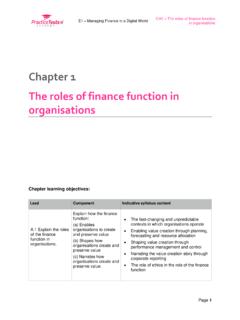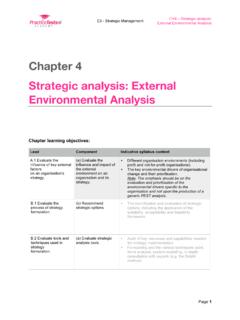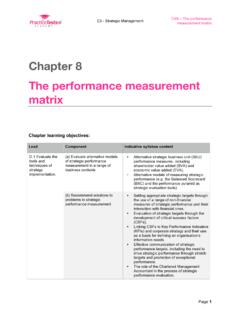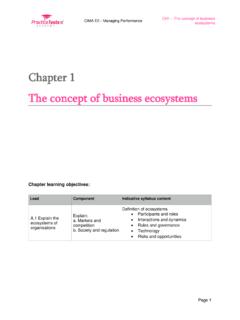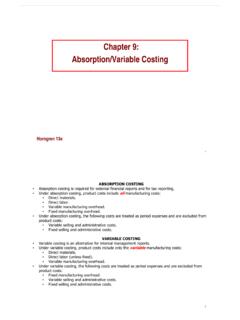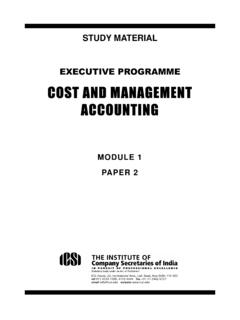Transcription of Chapter 1 Activity-based costing and activity-based …
1 P2 Advanced Management Accounting CH1 ABC and ABM Page 1 Chapter 1 Activity-based costing and Activity-based management Chapter learning objectives: Lead Component Indicative syllabus content Apply cost management and cost transformation methodology to manage costs and improve profitability. Apply the following to manage costs and improve profitability: (a) activity based management (ABM) methodology (b) Cost transformation techniques Engendering a cost-conscious culture Logic of ABC as the foundation or managing costs ABM to transform efficiency of repetitive overhead activities ABM to analyse and improve customer profitability ABM to analyse and improve channel performance P2 Advanced Management Accounting CH1 ABC and ABM Page 2 1. The importance of understanding costs In management accounting an understanding of costs is required in order to carry out the three main functions of planning, control and decision making.
2 The CGMA Cost transformation model The CGMA cost transformation model is designed to help businesses to achieve and maintain cost competitiveness: Engendering a cost conscious culture the organisation should aim to be a cost leader. Managing the risks that come from a cost conscious culture for example, reducing cost may result in reducing quality and customer satisfaction. The organisation should have a clear risk management process in place to identify, assess and manage such risks. Connecting products with profitability understanding what drives costs for each individual product and allocating shared costs to products as accurately as possible. Generating maximum value through new products Incorporating sustainability to optimise profits Understanding cost drivers this involves investigating costs to determine why they change and how different variables impact on the cost. P2 Advanced Management Accounting CH1 ABC and ABM Page 3 2. Activity-based costing In the late 1980s, Cooper and Kaplan developed a new approach ( Activity-based costing ) that assigns overheads to products to determine the product cost.
3 They claimed that ABC provides product-cost information that is useful for decision-making purposes. Activity-based costing is an approach to the costing and monitoring of activities which involves tracing resource consumption and costing final outputs. Resources are assigned to activities and activities to cost objects based on consumption estimates. The latter utilise cost drivers to attach activity costs to outputs. (CIMA Terminology) A look at traditional systems Traditional systems accurately measure volume-related resources that are consumed in proportion to the number of units produced of the individual product. Such resources include material, direct labour, energy and machine-related resources. But many organisational resources exist for activities that are not related to physical volume. Non-volume-related activities include supporting activities: o Material handling P2 Advanced Management Accounting CH1 ABC and ABM Page 4 o Material procurement o Set-ups o Production scheduling o First-time inspection activities Traditional product cost systems that assume that the products consume all activities in proportion to their production volumes thus reported distorted product costs.
4 In contrast to traditional cost-accounting systems, ABC systems first accumulate overhead costs for each organisational activity and then assign the costs of the activities to the products, services or customers (cost objects) causing that activity . The most critical aspect of ABC is activity analysis. This is the process of identifying appropriate output measures for activities and resources (cost drivers) and their effects on the costs of making a product or providing a service. activity analysis provides a foundation for remedying the distortions inherent in traditional cost-accounting systems. 3. The ABC process Cooper and Kaplan developed a simple three-step process on the basis that it is the supporting activities that cause many overheads. Support activities cause costs. Products consume cost activities. Costs should be charged to products on the basis of consumption of activities. ABC method Identify the organisation s major activities.
5 Estimate the cost associated with performing each activity . These costs are collected in the cost pool. Identify the cost drivers that affect the cost pool the number of set-ups will affect the cost of setting up the machinery. Calculate the cost driver rate, for example: A rate per set-up Rate per material requisition Rate per inspection Formula = P2 Advanced Management Accounting CH1 ABC and ABM Page 5 Charge the overheads to the products by applying the rates of the cost drivers to the activity usage of the product. 4. Activity-based cost hierarchy In 1991, Cooper and Kaplan proposed a cost hierarchy framework that maintains that costs are driven by and variable with respect to activities that occur at four levels. Unit-level activities Performed each time a unit is produced. Consumed in direct proportion to the number of units produced. These include: o Direct material o Direct labour o Energy costs o Machine maintenance Batch-level activities Performed each time a batch is produced.
6 Cost of batch-related activities varies with the number of batches made. But cost is common or fixed for all of the units in the batch. Product-sustaining activities Performed to support different products in the product line. Performed to enable different products to be produced and sold. P2 Advanced Management Accounting CH1 ABC and ABM Page 6 Resources consumed are independent of how many units and batches are being produced. Facility-sustaining activities Costs that cannot be associated with a particular product line. Related to maintaining the building and the facilities, including: o Maintenance of the building o Plant security o Business rates ABC has predominantly been used to support strategic decisions such as pricing, outsourcing, and identification and measurement of process improvement initiatives because: It helps to identify inefficient products, departments and activities. It helps to allocate more resources to profitable products, departments and activities.
7 It helps to control the costs at an individual level and on a departmental level. It helps to find unnecessary costs. It helps to fix the price of a product or service scientifically. 5. Benefits and limitations of ABC Benefits Limitations Provides more accurate product line costing in the instance of significant non-volume-related overheads and a diverse product line Flexible enough to analyse costs by cost objects other than products Provides a reliable indication of long-run variable product cost that is particularly relevant to managerial decision-making at the strategic level Provides meaningful financial and non-financial measures relevant to cost management and performance assessment at the operational level Aids identification and understanding of cost behaviour and thus has the potential to improve cost estimation A lack of evidence to date that ABC improves corporate profitability Deals with historic information that is internally oriented.
8 And hence lacks direct relevance to future strategic decisions Lacks practicality and gives rise to problems such as cost driver selection Could be viewed as simply a rigorous application of P2 Advanced Management Accounting CH1 ABC and ABM Page 7 Provides a logical, acceptable and comprehensible basis for costing work conventional costing procedures Test Your Understanding 1 ABC Sledge Company manufactures three types of tablets and operates a traditional absorption costing system. The company is now considering opting for using Activity-based costing (ABC) on a trial basis for its procurement operation. A time- based cost driver is used to charge the procurement costs to the tablets under the ABC system. The following unit manufacturing costs have been determined using traditional absorption costing and Activity-based costing . Product Traditional absorption costing Activity-based costing Tablet Star $80 $108 Tablet Air $101 $103 Tablet Galaxy $92 $84 Place each of the following statements in the grey cell beside the product to which it relates.
9 Tablet Star Tablet Air Tablet Galaxy Statement 1 Statement 2 Statement 3 This tablet uses a lot of parts and materials that are readily available. This tablet has relatively few components, and these are generally purchased in bulk. This tablet uses a lot of parts and materials that are difficult to obtain and so places the buying department under pressure. 6. Activity-based management (ABM) Activity-based management is a system of management which uses Activity-based cost information for a variety of purposes including cost reduction, cost modelling, and customer profitability analysis. (CIMA terminology) ABM simply uses the information derived from ABC analysis for cost management. It classifies each activity within a process as a value-added or non-value-added activity . Non-value-added activities are unnecessary and present waste. The aim should be to eliminate non-value-added activities. P2 Advanced Management Accounting CH1 ABC and ABM Page 8 ABM focuses on the activities within a process, decision making and planning relative to those activities, and the need for continuous improvement of all organisational activities.
10 Everyone in the management should cooperate in identifying: o Cost pools o Cost drivers o Key performance indicators They must be trained and empowered to act, all must be treated fairly, and success must be recognised. 7. Output from the ABM information system There are five basic information outputs from ABM. Cost of activities and business processes Activities form the very core of what a business does. The basic output of an ABM system must be relevant cost information about what a business does. Cost of non-value-added activities Identification of these wasteful activities is invaluable as it provides a crucial focal point for the management. Activity-based performance measures Determining the total cost of an activity is insufficient to measure activity performance. activity measures of quality, cycle time, productivity and customer service may also be required to judge performance. Measuring the performance of activities provides a scorecard reporting how well improvement efforts are working and is an integral part of continuous improvement.
